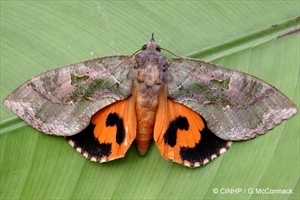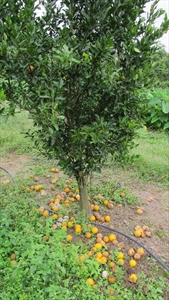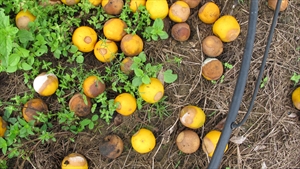- Widespread distribution. Not in Americas. On a wide range of cultivated and wild fruits, including banana, citrus, 5-corner fruit, guava, mango, passionfruit, pineapple and, in outbreak years, capsicum, melon and tomato. An important pest.
- Adult moths do the damage, causing serious outbreaks on citrus (>70%), tomatoes, capsicum, 5-corner fruit. Adults have a 25 mm long, barbed feeding tube to pierce the fruit and suck out the juices. Rots develop from the holes.
- Eggs laid on Erythrina trees, where larvae feed. Note, a gall wasp has decimated trees in some countries, and moth populations have declined.
- Natural enemies: not always sufficient to stop outbreaks.
- Cultural controls: early harvests; fruit bagging, nets.
- Chemical control: not practical; moths have minimal contact with fruit, and sprays near harvest may leave residues. Not feasible to cut down Erythrina trees.
Pacific Pests, Pathogens and Weeds - Online edition
Pacific Pests, Pathogens, Weeds & Pesticides
Citrus fruit piercing moth (113)
Click/tap on images to enlarge
Summary
Common Name
Fruit-piercing moth
Scientific Name
Eudocima fullonia; previously Othreis fullonia
AUTHOR Grahame Jackson
Information from Waterhouse DF, Norris KR (1987) Biological Control Pacific Prospects. Inkata Press. Assistance; and from Wilco Liebregts (pers. comm), Eco-Consult Pacific, Fiji. Photo 1 Gerald McCormack, Cook Islands Biodiversity & Natural Heritage. (http://cookislands.bishopmuseum.org/).
Produced with support from the Australian Centre for International Agricultural Research under project PC/2010/090: Strengthening integrated crop management research in the Pacific Islands in support of sustainable intensification of high-value crop production , implemented by the University of Queensland and the Secretariat of the Pacific Community.






